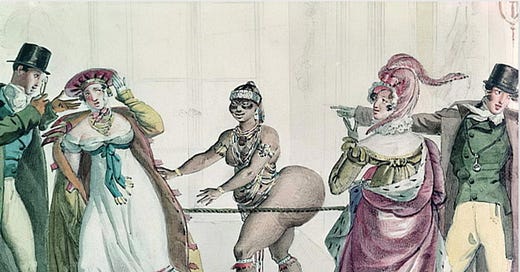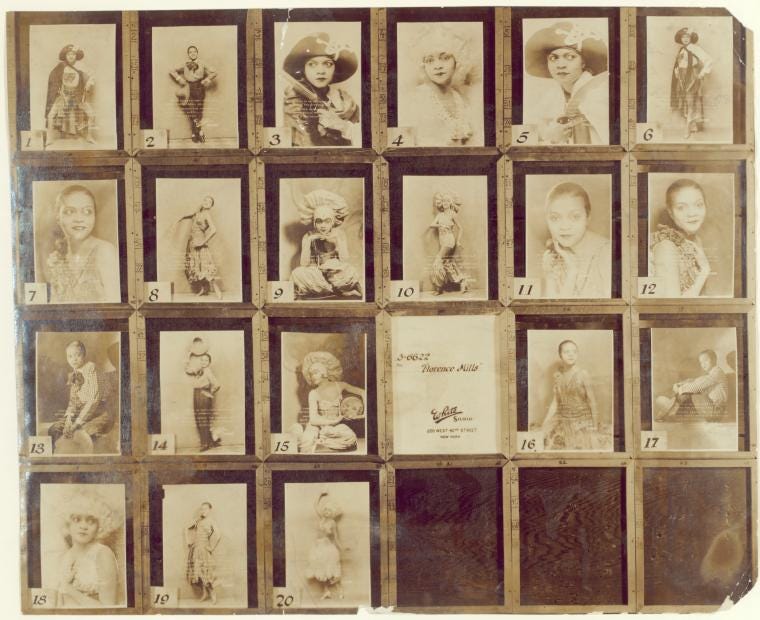'Fashioning the Black Female Body'
Black chorus girls, colonialism in Latin America, learning about the huipil and 'fearing the black body.'
Hello everyone,
I’ve got a great roundup for you this week and a crucial event to share (happening today!). As we begin a new month, things are ramping up over here with our Tommy Hilfiger partnership, and Anthony (our new Content Editor) and I are pouring over some excellent research pitches that have come in. In the meantime, I’d like to revisit a fabulous piece on Black chorus girls, get a conversation going on Latin America’s colonialist history (and grappling with racism), introduce you to a commonly appropriated garment from Central America, and invite you to an event that connects the “fashionable,” slender body with anti-Black racism. You can find the link to today’s event at the end of this newsletter.
Side note: Thanks to everyone who has sent us writing pitches! We are doing our best to respond and move forward on several of them. Likewise, thanks to everyone who has contacted us with interest in working at the database! We are a small (but mighty) operation, and we have a limited budget, as we depend on fundraising and partnerships. Once we receive more funding, we can expand our team.
Essay: ‘Fashioning the Black Chorus Girl’
What are the aesthetic associations of the chorus girl and showgirl? Parading across the stage in flamboyant costume while high-kicking, singing, and dancing as the audience erupts in applause for the talented beauty that presents itself before them. This imagery summons the thought of dazzling White beauty, especially in the historic sense when Black and White entertainment spaces were segregated by de facto and de jure practices. So, how did Black chorus girls claim a “Black is beautiful” aesthetic before the phrase even came into the vernacular? Through intellect, through performance, and most importantly, through fashion.
Read on as we return to this beautiful research piece by guest contributor Es-pranza Humphrey, who works as a museum educator and historian.
From The Library: ‘Representing Race in Colonial Latin America’

Researcher Laura Beltrán-Rubio has been doing brilliant work over here at the database, bringing complexity and nuance to the library we are building on Latin American history. This week, she’s exploring the construction and maintenance of race in colonial Latin America, and has put together a reading list for you to explore:
Constructs of race are the result of colonial enterprises and thought. Since the Spanish and Portuguese invasion of what we now call ‘Latin America,’ class, social economy, and cultural habits became important factors to categorize social groups into different ‘races.’ In this process, visual culture supported and shaped meanings of ‘race’ through the representation of human subjects and bodies. Dress, in particular, became an essential aspect of the classification of people into racial categories and their representation. These readings offer an introduction to the representation of race in Early Modern Latin America, particularly during the colonial period (roughly 16th–early 19th centuries).
Imagining Identity in New Spain: Race, Lineage, and the Colonial Body in Portraiture and Casta Paintings by Magali M. Carrera (Book)
Envisioning Others: Race, Color, and the Visual in Iberia and Latin America by Pamela A. Patton (Book)
An Eighteenth-Century Visual Representation of the Black Population in Trujillo del Perú: Picturing Cultural and Social Difference by Mariselle Meléndez (Paywall Article)
‘Customs and Costumes: Carlos Julião and the Image of Black Slaves in Late Eighteenth-Century Brazil’ by Silvia Hunold Lara (Paywall Article)
‘Gender, Sex, and Power: Images of Enslaved Women’s Bodies’ by Ana Lucia Araújo (Paywall Article)
‘The Library’ is where we collect and organize countless educational sources all in one place. Referenced by educators, students, fashion enthusiasts and curious minds, this multi-faceted repository provides an expanding selection of tools for learning about all matters connected to fashion, appearance, power and the impact of ‘race.’
Do you appreciate our content and research? Learn about our sponsorships or support us with a one-time or monthly, sustaining donation!
Objects That Matter: The Huipil

The huipil is a commonly appropriated and adapted garment from Central America that matters to us this week. FRD Researcher Laura Beltrán-Rubio tells us about the historical and cultural significance that is sometimes lost on designers, tourists and in vintage shops:
The huipil is a blouse-like garment worn by women in Mesoamerica since at least 2,000 years ago. The name huipil derives from the Nahuatl word “huipilli,” used by the Aztecs to denote this garment. However, the huipil can receive different names, according to the Native languages spoken by the cultures that wear it. For example, in Maya Tzotzil, the huipil is known as k’u’il or chilil…
The motifs, colors, and weaving techniques were representative of the different Aztec and Maya cultures that created and wore the garment, as well as of the status of the weaver and wearer of the huipil.
Continue learning about the huipil in the latest entry from ‘Objects That Matter.’
'Objects That Matter' gathers numerous fashion objects outside of the Western lens and provides a brief history, showing why they matter, as many of these items have been widely appropriated or referenced.
The Calendar: ‘Fashioning the Black Female Body: Negrophilia/negrophobia and the Racial Economy of Desire’ (TODAY at 1:30pm EDT)
About this event:
The aesthetic arts have traditionally undertheorized how women’s bodies are shaped and molded to communicate prestige and belonging, or the lack thereof. While recent work in the field has started to address the relationship between fashions of feminine embodiment and social appeal, far less work has taken an intersectional approach to query how race and gender collide to magnify, upend, or reframe the tenets of desirability. In this presentation, I reveal how the transition in idealized feminine forms, from the voluptuous to the slender aesthetic, resulted from the rise and spread of slavery. I argue that as a growing number of Black women were taken to Europe and America, and increasingly represented within the aesthetic arts, their figures and attire were first used to incorporate them into the domestic economy of elite Europeans. But, they were later used to banish them from the sexual and romantic economy of this same space. I conclude that the titillating/terrifying specter of voluptuous Black women within the aesthetic arts was used as a bulwark against racial integration.
This talk is co-sponsored by the Central New York Humanities Corridor from an award by the Andrew W. Mellon Foundation, Department of Fiber Science and Apparel Design, Department of History, and the American Studies Program. Dr. Strings will be the inaugural speaker in the “Fashion & Social Justice” lecture series, which is hosted by the “Decolonizing Fashion Studies: Rethinking Curriculum, Collections, and Creative Practice” Central NY Humanities Corridor working group.
Visit our calendar page for this event to register. Also, check out Dr. Sabrina Strings’ book, Fearing the Black Body: The Racial Origins of Fat Phobia in our library.
A global network of events, conversations and opportunities will continue to evolve the discourse on fashion and race. ‘The Calendar’ remains on the pulse and keeps you looped in.
That’s it for now. Please stay safe and we’ll see you next week.
Yours in service and solidarity,
Kim Jenkins
The Fashion and Race Database Team: Rachel Kinnard, Daniela Hernandez, Kai Marcel, Laura Beltrán-Rubio and Anthony Palliparambil, Jr.





